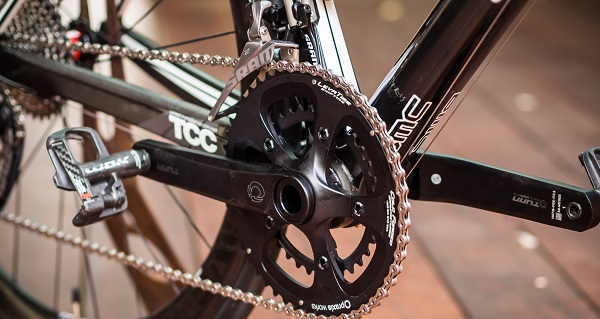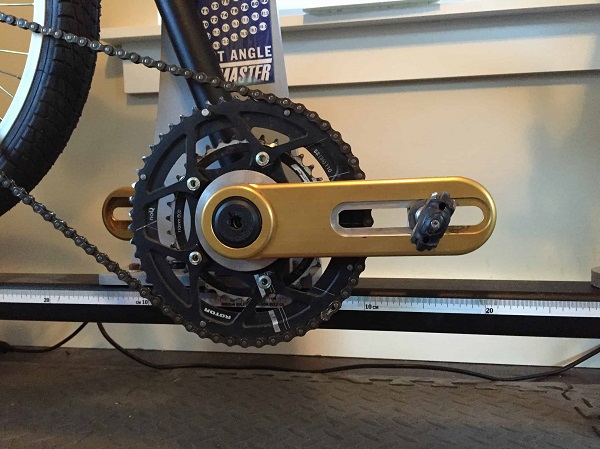One aspect that goes unnoticed by most cyclists is the length of your bike’s cranks. Most of us happily ride our bikes with manufacturer-supplied cranks regardless of their features and whether they in any way affect our performance on the pedals.
Even when we configure our bicycle through a bike fitting, we usually focus on the height of the saddle, the reach (reach), the shoe/pedal interface and other aspects so that they are in accordance with the functions of our anatomy and thus, obtain the maximum comfort and best performance. However, we generally overlook the importance of the cranks on our bikes.
Not all legs were created equal

And although it would seem obvious to think that the length of the cranks of a bicycle responds to the different lengths of legs that cyclists present, this has not always been the case. Well, for years, 99.9% of road and mountain bikes for adults have been equipped with crankarms (cranks) with lengths between 165 and 175 mm.
However, bike and gear manufacturers have realized these differences between riders and have been introducing more sizes because we’re just not all the same and there are riders for whom standard-size cranks don’t work well. You can interested to read also: Womens bikes size guide.
Bicycle cranks with different lengths
Although the options are still limited, today it is possible that we find levers for pedals that vary from 165 to 180 mm in length, and that is only from Shimano and SRAM because other firms are also manufacturing different lengths of cranks that go from 130 to 220 mm. For satisfying the different lengths of legs that a cyclist, man or woman can present. Keep reading https://pluginid.com/is-it-worth-getting-a-bike-repair-stand/
How to measure crank length
There are two ways to know the size of the cranks. One is by identifying the nomenclature that the manufacturer has marked on the part. This is generally located on the inside of the lever, near the hole where the pedal spindle is screwed in. This can vary and be found somewhere else on the inside of the part.
The other is to measure it directly from one end of the crank, from the center of the bottom bracket to the center of the hole where the pedal spindle is inserted.
Influence of crank size on pedaling
The length of the cranks does not significantly affect the performance of the cyclist since physical performance is determined by the force that the cyclist exerts and the cadence of each pedal stroke.
However, there is a consensus in which it is thought that when pedaling with shorter cranks, we lose the ability to produce more energy as the lever is shorter. But, on a gearshift bike, this is not the case.
Well, on a bike with different gears, we change gears to adapt to a shorter lever, so the length of the crank will not make a difference when the pedaling speed is optimal for the rider. The gears compensate for the effect of the crank length.
Crank length does not affect rider performance
A longer crank does not mean more energy and, therefore, more speed since the maximum pedaling force in a cyclist is produced when the pedal is at 12 o’clock. And a longer crankarm, the leg has to reach past the top of the pedal cycle before the same mechanical advantage can be applied, so a longer crank doesn’t mean more torque or force.
But in contrast, shorter cranks are more efficient in the form of the rider’s lower oxygen requirement, where pedal speed along its axis or travel circumference, not cadence, remains the same.
And since the higher the pedal speed, the higher the oxygen consumption. Where the pedal speed is higher with a longer crank, the pedal stroke cycle is larger in diameter and the need for oxygen increases.
Obviously, these variables are perceptible in high-performance cycling, where a small decrease in the cranks can have a positive effect due to the change of 5 mm in the maximum knee height, taking into account that of those 5 mm, 2.5 mm they are of increase in the height of the saddle and of 2.5 in the crank.
Determine the length of your cranks
There is no single method of knowing the optimal length for your bike cranks. Among the most used are those that are based on the body of the cyclist as a guide, such as this one that is directly related to the height of the cyclist.
These measurements can be increased between 2.5 mm and even up to 5 mm, in the case of bicycles for competition.
| Height | Crank length |
|---|---|
| Less than 1.52 meters. | 160 mm |
| Between 1.52 and 1.68 mts. | Between 165 and 167.5 mm |
| Between 1.68 and 1.83 mts. | 170 mm. |
| Between 1.83 and 1.89 mts. | 172.5 mm. |
| Between 1.89 and 195 mts. | 175 mm. |
| More than 1.95 mts. | Between 180 and 185 mm. |
Likewise, we have the one that establishes the length of the cranks based on the measurement of the cyclist’s crotch.
| Crotch length | Crank length |
|---|---|
| Between 60 and 65 cm. | 150 mm. |
| Between 66 and 70 cm. | 155 mm. |
| Between 72 and 75 cm. | 160 mm. |
| Between 75 and 78 cm. | 162.5 mm. |
| Between 79 and 81 cm. | 165 mm. |
| Between 82 and 83 cm. | 167.5 mm. |
| Between 83 and 86 cm. | Between 170 and 172.5 mm. |
| Between 87 and 90 cm. | Between 175 and 177.5 mm. |
| Between 91 and 94 cm. | 180 mm. |
| More than 94 cm. | 185 mm. |
With the information collected in this text, anyone will be able to select the correct connecting rods according to their length without causing future damage to the body.
However, if you want to be sure or have doubts about the correct measurement of your cranks, you can go to a professional to carry out a study to precisely determine the correct value that determines the length of your cranks. Remember that a bike fitting is a mix between science and art, so once again, testing will be essential to be sure about the length of the bicycle cranks.

